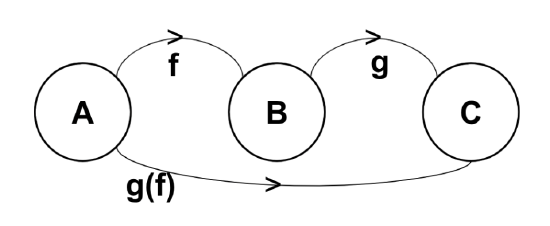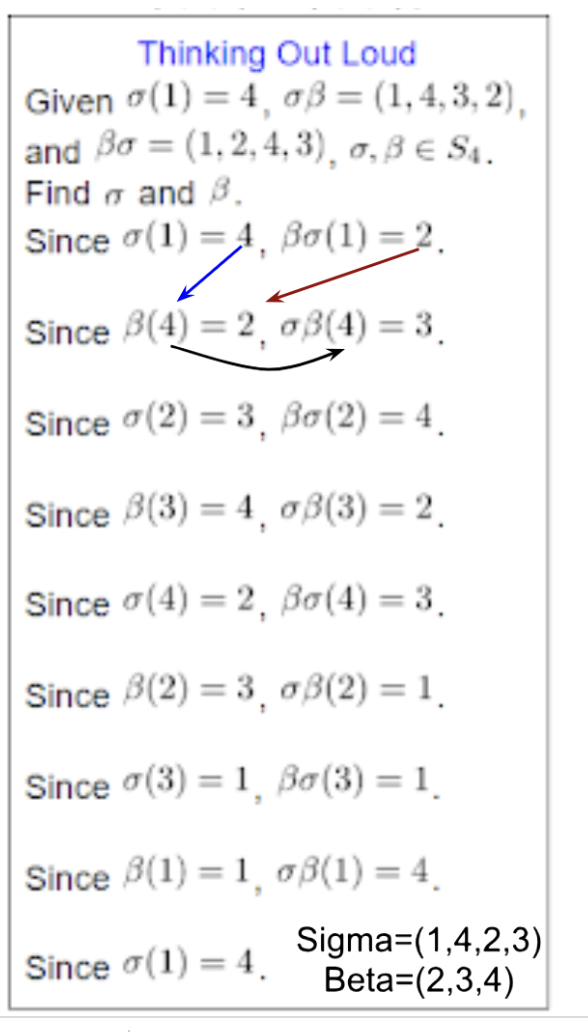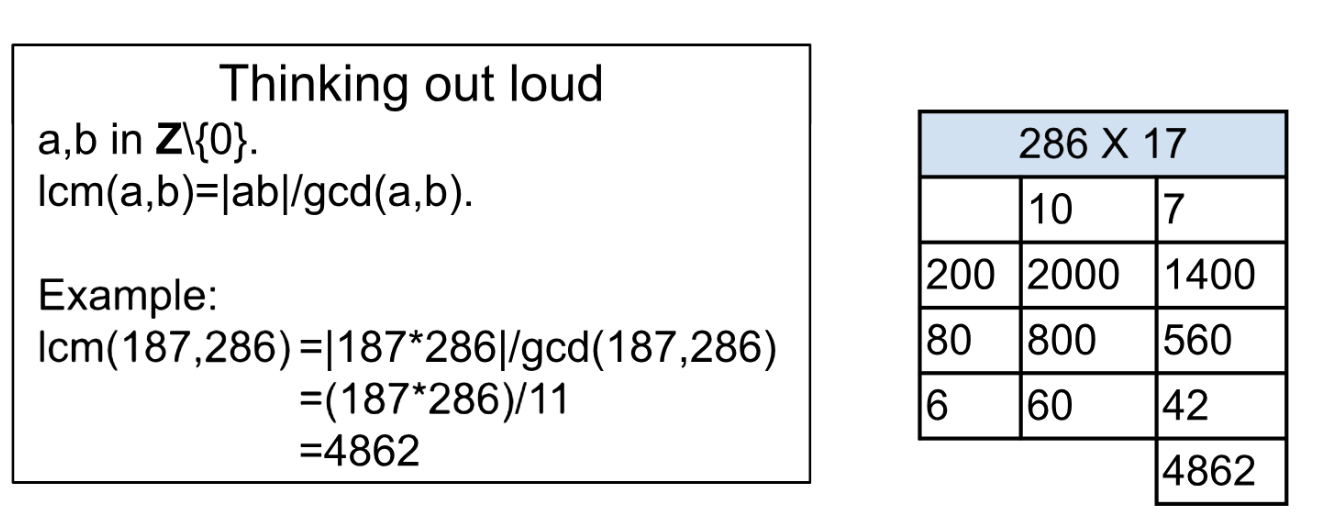3.1: Symmetric Groups
- Page ID
- 131846
\( \newcommand{\vecs}[1]{\overset { \scriptstyle \rightharpoonup} {\mathbf{#1}} } \)
\( \newcommand{\vecd}[1]{\overset{-\!-\!\rightharpoonup}{\vphantom{a}\smash {#1}}} \)
\( \newcommand{\dsum}{\displaystyle\sum\limits} \)
\( \newcommand{\dint}{\displaystyle\int\limits} \)
\( \newcommand{\dlim}{\displaystyle\lim\limits} \)
\( \newcommand{\id}{\mathrm{id}}\) \( \newcommand{\Span}{\mathrm{span}}\)
( \newcommand{\kernel}{\mathrm{null}\,}\) \( \newcommand{\range}{\mathrm{range}\,}\)
\( \newcommand{\RealPart}{\mathrm{Re}}\) \( \newcommand{\ImaginaryPart}{\mathrm{Im}}\)
\( \newcommand{\Argument}{\mathrm{Arg}}\) \( \newcommand{\norm}[1]{\| #1 \|}\)
\( \newcommand{\inner}[2]{\langle #1, #2 \rangle}\)
\( \newcommand{\Span}{\mathrm{span}}\)
\( \newcommand{\id}{\mathrm{id}}\)
\( \newcommand{\Span}{\mathrm{span}}\)
\( \newcommand{\kernel}{\mathrm{null}\,}\)
\( \newcommand{\range}{\mathrm{range}\,}\)
\( \newcommand{\RealPart}{\mathrm{Re}}\)
\( \newcommand{\ImaginaryPart}{\mathrm{Im}}\)
\( \newcommand{\Argument}{\mathrm{Arg}}\)
\( \newcommand{\norm}[1]{\| #1 \|}\)
\( \newcommand{\inner}[2]{\langle #1, #2 \rangle}\)
\( \newcommand{\Span}{\mathrm{span}}\) \( \newcommand{\AA}{\unicode[.8,0]{x212B}}\)
\( \newcommand{\vectorA}[1]{\vec{#1}} % arrow\)
\( \newcommand{\vectorAt}[1]{\vec{\text{#1}}} % arrow\)
\( \newcommand{\vectorB}[1]{\overset { \scriptstyle \rightharpoonup} {\mathbf{#1}} } \)
\( \newcommand{\vectorC}[1]{\textbf{#1}} \)
\( \newcommand{\vectorD}[1]{\overrightarrow{#1}} \)
\( \newcommand{\vectorDt}[1]{\overrightarrow{\text{#1}}} \)
\( \newcommand{\vectE}[1]{\overset{-\!-\!\rightharpoonup}{\vphantom{a}\smash{\mathbf {#1}}}} \)
\( \newcommand{\vecs}[1]{\overset { \scriptstyle \rightharpoonup} {\mathbf{#1}} } \)
\( \newcommand{\vecd}[1]{\overset{-\!-\!\rightharpoonup}{\vphantom{a}\smash {#1}}} \)
\(\newcommand{\avec}{\mathbf a}\) \(\newcommand{\bvec}{\mathbf b}\) \(\newcommand{\cvec}{\mathbf c}\) \(\newcommand{\dvec}{\mathbf d}\) \(\newcommand{\dtil}{\widetilde{\mathbf d}}\) \(\newcommand{\evec}{\mathbf e}\) \(\newcommand{\fvec}{\mathbf f}\) \(\newcommand{\nvec}{\mathbf n}\) \(\newcommand{\pvec}{\mathbf p}\) \(\newcommand{\qvec}{\mathbf q}\) \(\newcommand{\svec}{\mathbf s}\) \(\newcommand{\tvec}{\mathbf t}\) \(\newcommand{\uvec}{\mathbf u}\) \(\newcommand{\vvec}{\mathbf v}\) \(\newcommand{\wvec}{\mathbf w}\) \(\newcommand{\xvec}{\mathbf x}\) \(\newcommand{\yvec}{\mathbf y}\) \(\newcommand{\zvec}{\mathbf z}\) \(\newcommand{\rvec}{\mathbf r}\) \(\newcommand{\mvec}{\mathbf m}\) \(\newcommand{\zerovec}{\mathbf 0}\) \(\newcommand{\onevec}{\mathbf 1}\) \(\newcommand{\real}{\mathbb R}\) \(\newcommand{\twovec}[2]{\left[\begin{array}{r}#1 \\ #2 \end{array}\right]}\) \(\newcommand{\ctwovec}[2]{\left[\begin{array}{c}#1 \\ #2 \end{array}\right]}\) \(\newcommand{\threevec}[3]{\left[\begin{array}{r}#1 \\ #2 \\ #3 \end{array}\right]}\) \(\newcommand{\cthreevec}[3]{\left[\begin{array}{c}#1 \\ #2 \\ #3 \end{array}\right]}\) \(\newcommand{\fourvec}[4]{\left[\begin{array}{r}#1 \\ #2 \\ #3 \\ #4 \end{array}\right]}\) \(\newcommand{\cfourvec}[4]{\left[\begin{array}{c}#1 \\ #2 \\ #3 \\ #4 \end{array}\right]}\) \(\newcommand{\fivevec}[5]{\left[\begin{array}{r}#1 \\ #2 \\ #3 \\ #4 \\ #5 \\ \end{array}\right]}\) \(\newcommand{\cfivevec}[5]{\left[\begin{array}{c}#1 \\ #2 \\ #3 \\ #4 \\ #5 \\ \end{array}\right]}\) \(\newcommand{\mattwo}[4]{\left[\begin{array}{rr}#1 \amp #2 \\ #3 \amp #4 \\ \end{array}\right]}\) \(\newcommand{\laspan}[1]{\text{Span}\{#1\}}\) \(\newcommand{\bcal}{\cal B}\) \(\newcommand{\ccal}{\cal C}\) \(\newcommand{\scal}{\cal S}\) \(\newcommand{\wcal}{\cal W}\) \(\newcommand{\ecal}{\cal E}\) \(\newcommand{\coords}[2]{\left\{#1\right\}_{#2}}\) \(\newcommand{\gray}[1]{\color{gray}{#1}}\) \(\newcommand{\lgray}[1]{\color{lightgray}{#1}}\) \(\newcommand{\rank}{\operatorname{rank}}\) \(\newcommand{\row}{\text{Row}}\) \(\newcommand{\col}{\text{Col}}\) \(\renewcommand{\row}{\text{Row}}\) \(\newcommand{\nul}{\text{Nul}}\) \(\newcommand{\var}{\text{Var}}\) \(\newcommand{\corr}{\text{corr}}\) \(\newcommand{\len}[1]{\left|#1\right|}\) \(\newcommand{\bbar}{\overline{\bvec}}\) \(\newcommand{\bhat}{\widehat{\bvec}}\) \(\newcommand{\bperp}{\bvec^\perp}\) \(\newcommand{\xhat}{\widehat{\xvec}}\) \(\newcommand{\vhat}{\widehat{\vvec}}\) \(\newcommand{\uhat}{\widehat{\uvec}}\) \(\newcommand{\what}{\widehat{\wvec}}\) \(\newcommand{\Sighat}{\widehat{\Sigma}}\) \(\newcommand{\lt}{<}\) \(\newcommand{\gt}{>}\) \(\newcommand{\amp}{&}\) \(\definecolor{fillinmathshade}{gray}{0.9}\)Let \(n\in \mathbb{N}\). Let \(X=\{1,\ldots,n\}\), be a set. Then \(S_n\) is the set of all the bijections from \(X\) to \(X\) (permutations). Note that there are \(n!\) permutations. The operation \(\star : = \) composition of bijections. Note that it is a right-to-left composition.

\(S_n\) with compositions forms a group; this group is called a Symmetric group. \(S_n\) is a finite group of order \(n!\) and are permutation groups consisting of all possible permutations of n objects.
Identity permutation is denoted as \(e\).
We will denote a permutation by \(\sigma = \begin{bmatrix} 1 & 2& 3& \cdots & n\\
\sigma(1) & \sigma(2) & \sigma(3) & \cdots & \sigma(n) \end{bmatrix} \in S_n\)
Let \(\sigma = \begin{bmatrix} 1 & 2& 3& 4 & 5\\
2 & 4 & 3 & 5 & 1 \end{bmatrix} \in S_5\) and
\( \gamma = \begin{bmatrix} 1 & 2& 3& 4 & 5\\
5 & 4 & 1 & 2 & 3 \end{bmatrix} \in S_5 \).
Lets find \(\gamma \circ \sigma\).

Figure \(\PageIndex{2}\) illustrates the process of moving from one function to another. Note the system is closed since it is a bijection. Completing the process, we obtain the following:
Consider \(\gamma \circ \sigma = \gamma \sigma =\) \(\begin{bmatrix} 1 & 2& 3& 4 & 5\\
5 & 4 & 1 & 2 & 3 \end{bmatrix} \begin{bmatrix} 1 & 2& 3& 4 & 5\\
2 & 4 & 3 & 5 & 1 \end{bmatrix}= \begin{bmatrix} 1 & 2& 3& 4 & 5\\
4 & 2 & 1 & 3 & 5 \end{bmatrix} \)
Note, if we switch the order of the functions are switched, we obtain: \(\sigma \gamma = \begin{bmatrix} 1 & 2& 3& 4 & 5\\
1 & 5 & 2 & 4 & 3 \end{bmatrix}\).
Note that \(\sigma \gamma \ne \gamma \sigma\). To prove not abelian, we need only show that for at least one element, \(k\), \(\sigma \gamma(k) \ne \gamma \sigma(k)\).
The inverse of a permutation \(\sigma\) is the inverse of the function \(\sigma\), and it is denoted by \(\sigma^{-1}\).
Thus, \(\sigma^{-1} \sigma=\sigma \sigma^{-1}=e.\)
Let \(\sigma = \begin{bmatrix} 1 & 2& 3& 4 & 5\\
2 & 4 & 3 & 5 & 1 \end{bmatrix} \in S_5\). Then Let \(\sigma^{-1} = \begin{bmatrix} 1 & 2& 3& 4 & 5\\
5 & 1 & 3 & 2 & 4 \end{bmatrix} \in S_5\).
Cycle Notation
Cycle notation, a simple and straightforward method, is a convenient way to represent permutations in the symmetric group. For example:
Let \(\gamma = \begin{bmatrix} 1 & 2& 3& 4 & 5\\
5 & 4 & 1 & 2 & 3 \end{bmatrix}=(1,5,3)(2,4)\).

- \((1,2,4,5)\) means that 1 goes to 2, 2 goes to 4, 4 goes to 5 and 5 goes to 1. Note that 3 is not included, so 3 goes to 3.
- There is no cycle notation in the case of the identity, \(e\), and we use \(e\).
-
The cycles are always listed in a logical and clear order-descending order of their smallest element.
-
If the permutation fixes an element (i.e., it remains unchanged), it is often omitted from the cycle notation.
A cycle \(\gamma=(a_1,\ldots,a_k)\) means 
Disjoint cycles mean that the elements involved in one cycle are distinct from those in another.
Two cycles in \(S_n\), \(\gamma=(a_1,\ldots,a_k)\) and \(\sigma=(b_1,\ldots,b_l)\) are disjoint if \(a_i \ne b_j, \; \forall i,j\).
Note that the length of the cycles does not need to be the same.
Example: \((1, 2)\) and \((3, 4)\) are disjoint, but \((1, 2, 3)\) and \((3, 4)\) are not disjoint.
Let \( \sigma = \begin{bmatrix} 1 & 2& 3& 4 & 5& 6 & 7 & 8 & 9 &10 &11&12\\
12 & 2 & 3 & 1 & 11 & 9 & 5 &10 & 6 &4& 7 & 8 \end{bmatrix} \)
Then, a cycle decomposition of
\( \sigma = (1, 12, 8, 10, 4) (2)(3)(5,11,7)(6,9)= (1, 12, 8, 10, 4) (5,11,7)(6,9) \).
Note that these are disjoint cycles; therefore, they commute.
1. Disjoint cycles are commutative.
Let \(\gamma\) and \(\sigma\) be disjoint cycles, then \(\gamma \sigma = \sigma \gamma\).
2. Every permutation of a finite set can be written as a cycle or a product of disjoint cycles.
The inverse of a cycle:
\((a_1, a_2, \cdots, a_k)^{-1}= (a_k, a_{k-1}, \cdots, a_1)\)
\( (1,2,3)^{-1} = (3,2,1) \), and \((1,2)^{-1}=(2,1)=(1,2).\)
Let \( \sigma = \begin{bmatrix} 1 & 2& 3& 4 & 5& 6 & 7 & 8 & 9 &10 &11&12\\
12 & 2 & 3 & 1 & 11 & 9 & 5 &10 & 6 &4& 7 & 8 \end{bmatrix} = (1, 12, 8, 10, 4) (5,11,7)(6,9). \)
In a cycle decomposition, to find the inverse, just reverse the order of the cycles and find the inverse of each cycle. Hence,
\( \sigma^{-1} =(6,9)^{-1}(5, 11, 7)^{-1} (1, 12, 8, 10, 4)^{-1}=(9,6)(7, 11, 5) (4, 10, 8, 12, 1) \)
Note that disjoint cycles are commutative!
\((2,3)(1,2) = (1,3,2) =(3,2,1)=(2,1,3)\) Note: 1 goes to 2 first, then to 2 and then gets to 3.
\((1,2)(2,3)= (1,2,3)=(2,3,1)=(3,1,2)\) Note: Since there is no 1 in the inner function, it goes to itself and then goes to 2.
Type of a permutation (cycle structure of a permutation)
The type of a permutation (or cycle structure of a permutation) is the integer partition formed from the cycle lengths in decreasing order. We will denote it by type(\(\sigma \)), where \(\sigma \) is a permutation in \(S_n\).
Let \(\gamma = \begin{bmatrix} 1 & 2& 3& 4 & 5\\
5 & 4 & 1 & 2 & 3 \end{bmatrix}=(1,5,3)(2,4) \in S_5\).
The type of \(\gamma\) is, type \( (\gamma)=\)3 2.
Let \(\sigma = \begin{bmatrix} 1 & 2& 3& 4 \\
4 & 1 & 2 & 3 \end{bmatrix}=(1,4,3,2) \in S_4\).
The type \( \sigma\) is, type \( (\sigma)=\)4.
A partition of a positive integer \(n\) is a sum of nonnegative integers \(n=k_1+\cdots+k_s, k_i \in \mathbb{N},\) where the order of the summand is not important. For example:
The partitions of \(6\) are \(6, 5+1, 4+2, 4+1+1 , 3+3, 3+2+1, 3+1+1+1, 2+2+2, 2+2+1+1, 2+1+1+1+1, 1+1+1+1+1+1.\)
How many permutations in \(S_6\) have type 321?
Type \((321)\) permutation is of the form \( (_,_,_)(_,_)(_) \). There are \(6!\) ways of filling the blanks. Note that each cycle can be restarted anywhere.
Hence, the number of permutations in \(S_6\) have type (321) is \(\dfrac{6!}{(3)(2)(1)}.\)
How many permutations in \(S_6\) have \(3\) cycles of length \(2\)?
The permutation is of the form \( (_,_)(_,_)(_,_) \). There are \(6!\) ways of filling the blanks. Since each cycle has two representations matching this format (by restarting at any two places), so divided by \(2^3\).
The order of the whole cycle can be changed while keeping the pattern. Divide by \(3!\) ways to reorder the cycles.
Hence, the number of permutations in \(S_6\) have \(3\) cycles of length \(2\) is \(\dfrac{6!}{(2^3)(3!)}.\)
Suppose the number of cycles of length \(i\) is \(m_i\), for \(i=1, \cdots, k.\) and \(n=m_1+2m_2+\cdots+(k-1)m_{(k-1)}+ km_k.\)
The number of permutations in \(S_n\) of the type \((m_k m_{(k-1)} \cdots m_1)\) is
\(\dfrac{n!}{1^{m_1}2^{m_2}\cdots k^{m_k} {m_1}! m_2! \cdots m_k!}.\)
\(|S_3|=3!=2\cdot 3=6\).
| Table \(\PageIndex{1}\): Cycle type for \(S_3\) | |||
| Cycle type |
111 |
21 |
3 |
| Number of permutations |
\(\dfrac{3!}{1^3 3!}=1\) |
\(\dfrac{3!}{1^1 2^1 1!1!}=3\) |
\(\dfrac{3!}{ 3^1 1!1!}=2\) |
Notation:
\(1 \equiv \begin{pmatrix}
1 & 2 & 3\\
1 & 2 & 3
\end{pmatrix}\) the identity matrix.
\((1,2) \equiv \begin{pmatrix}
1 & 2 & 3\\
2 & 1 & 3
\end{pmatrix}\). Note that 3 points to itself.
\((1,2,3) \equiv \begin{pmatrix}
1 & 2 & 3\\
2 & 3 & 1
\end{pmatrix}\).
\((1,3,2) \equiv \begin{pmatrix}
1 & 3 & 2\\
3 & 2 & 1
\end{pmatrix}\).
Hence, \(S_3= \{e,(1,2),(1,3), (2,3), (1,2,3),(1,3,2)\}\).
|
Table \(\PageIndex{2}\): Cayley table for \(S_3\)
|
||||||
|
e |
(1,2,3) |
(1,3) |
(1,2) |
(2,3) |
(1,3,2) |
|
|
e |
e |
(1,2,3) |
(1,3) |
(1,2) |
(2,3) |
(1,3,2) |
|
(1,2,3) |
(1,2,3) |
(1,3,2) |
(2,3) |
(1,3) |
(1,2) |
e |
|
(1,3) |
(1,3) |
(1,2) |
e |
(1,2,3) |
(1,3,2) |
(2,3) |
|
(1,2) |
(1,2) |
(2,3) |
(1,3,2) |
e |
(1,2,3) |
(1,3) |
|
(2,3) |
(2,3) |
(1,3) |
(1,2,3) |
(1,3,2) |
e |
(1,2) |
|
(1,3,2) |
(1,3,2) |
e |
(1,2) |
(2,3) |
(1,3) |
(1,2,3) |
Let's explore \(S_4\). Note \(S_4\) has \(4!=24\) elements.
| Table \(\PageIndex{3}\): Cycle type for \(S_4\) | |||||
| Cycle type |
1111 |
211 |
22 |
31 |
4 |
|
Number of permutations |
\(\dfrac{4!}{1^4 4!}=1\) |
\(\dfrac{4!}{1^2 2^1 2!1!}=6\) |
\(\dfrac{4!}{ 2^2 2!}=3\) |
\(\dfrac{4!}{1^1 3^1 1!1!}=8\) |
\(\dfrac{4!}{4^1 1!}=6\) |
Hence, \[S_4=\{e, (1,2), (1,3), (1,4), (2,3), (2,4), (3,4),(1,2)(3,4), (1,3)(2,4), (1,4)(2,3), (1,2,3), (1,3,2), (2,3,4), (2,4,3), (3,4,1), (3,1,4), (4,1,2), (4,2,1),(1,2,3,4), (1,2,4,3), (1,3,4,2), (1,3,2,4), (1,4,2,3), (1,4,3,2) \}. \]
Notice that all the elements in \(S_3\) in \(S_4\).
The following theorem proves that \(S_n\) are non-Abelian for integer n ≥ 3, which means that the order in which we compose permutations matters.
\(S_n\) is non-Abelian for all integers n ≥ 3.
- Proof
-
Let \(a,b \in S_3\).
We will show that there exists \(a, b \in S_n, s.t. ab \ne ba \), \(n \ge 3\).
Note \(S_3=\{e,(1,2),(1,3),(2,3),(1,2,3),(1,3,2)\}\).
Let \(a=(1,2)\) and \(b=(2,3)\) both elements of \(S_3\).
Consider \(ab=(1,2)(1,3)=(1,3,2)\) and \(ba=(1,3)(1,2)=(1,2,3)\).
Since \((1,3,2) \ne (1,2,3)\), \(ab\ne ba \; \forall a,b \in S_3\), thus \(S_3\) is non-abelian.
Since \(a,b \le S_n, \; \forall n \ge 3\), \(S_n\) in non-abelian for \(n\ge 3\).◻
Given \(\alpha, \beta \in S_4\) with \(\alpha \beta =(1,4,3,2), \; \beta \alpha = (1,2,4,3)\), and \(\alpha(1)=4\), determine \(\alpha\) and \(\beta\).
Solution:
Let \(\alpha=(1,4,c,d)\) and \(\beta=(w,x,y,z)\).
Since \(\alpha(1)=4\) and \(\beta \alpha(1)=2\), implies \(\beta(4)=2\).
Since \(\beta(4)=2\) and \(\alpha \beta(4)=3\), implies \(\alpha(2)=3\).
Since \(\alpha(2)=3\) and \(\beta \alpha(2)=4\), implies \(\beta(3)=4\).
Since \(\beta(3)=4\) and \(\alpha \beta(3)=2\), implies \(\alpha(4)=2\).
Since \(\alpha(4)=2\) and \(\beta \alpha(4)=3\), implies \(\beta(2)=3\).
Since \(\beta(2)=3\) and \(\alpha \beta(2)=1\), implies \(\alpha(3)=1\).
Since \(\alpha(3)=1\) and \(\beta \alpha(3)=1\), implies \(\beta(1)=1\).
\(\alpha=(1,4,2,3)\) and \(\beta=(2,3,4)\).
Then \(\beta \alpha =(2,3,4)(1,4,2,3)=(2,4,3,1)=(1,2,4,3)\).
And \(\alpha \beta =(1,4,2,3)(2,3,4)=(4,3,2,1)=(1,4,3,2)\).
Note that every permutation of a finite set can be written as a cycle or a product of disjoint cycles.
2 Cycle (Transposition)
\((i,j), \; i\le j, \; j\le n, \; i \ne j\).
\((i,j)^{-1}=(j,i)=(i,j)\).
(1, 3, 2) = (1, 2) (1, 3) 1 goes to 3, 3 goes to itself, then to 1 then to 2.
(1, 2, 3) = (1, 3) (1, 2).
(2, 4, 1, 3, 5) = (2, 5) (2, 3) (2, 1) (2, 4)
Note: Any cycle can be written as a composition of two cycles.
A \(k-\)cycle \( (i_1,i_2\cdots, i_k) \) can be decomposed into a product of \(k-1\) transpositions. That is,
\( (i_1,i_2\cdots, i_k)=(i_1,i_k)(i_1, i_{k-1})\cdots (i_1,i_2). \)
Every permutation in \(S_n\) can be expressed as a product of 2-cycles (Transpositions). The number of transpositions will either always be even or odd.
If a permutation α can be expressed as a product of an even number of 2-cycles, then every decomposition of α into a product of 2-cycles has an even number of 2-cycles. A similar statement holds for odd.
Permutation parity
Let \(\sigma \in S_n\). (i.e. a permutation)
Then
(1) \(\sigma\) is an even permutation if \(\sigma\) can be expressed as a product of an even number of two cycles (transpositions).
(2) \(\sigma\) is an odd permutation if \(\sigma\) can be expressed as a product of an odd number of two cycles (transpositions).
1. A cycle of even length is odd.
2. A cycle of odd length is even.
1. let’s explore \(S_4\). Note \(S_4\) has \(4!=24\) elements.
Consider \(S_4=\{e, (1,2), (1,3), (1,4), (2,3), (2,4), (3,4),(1,2)(3,4), (1,3)(2,4), (1,4)(2,3), (1,2,3),(1,3,2), (2,3,4), (2,4,3), (3,4,1), (3,1,4), (4,1,2), (4,2,1),(1,2,3,4), (1,2,4,3), (1,3,4,2), (1,3,2,4), (1,4,2,3), (1,4,3,2) \}\)
2. Find the center of \(S_4\).
Since all symmetrical groups, \(S_n\), \(n \ge 3\), are non-abelian, the centre of \(S_4\) is trivial, being the identity e, or (1)(2)(3)(4). (what do you think of this proof? Is this a valid argument?)
Alternatively, proof by exhaustion: Having tried all \(x \in S_4\), the only \( x \in S_4\) that satisfies \(xg=gx, \; \forall g \in S_4\) is the identity.
3. Find the cyclic subgroup of \(S_4\) that has an order of 4.
The subgroup of \(S_4, C4 =\{e, (1,2,3,4),(1,3)(2,4),(1,4,3,2) \}\), has an order 4 and is generated by \((1,2,3,4)\).
\((1,2,3,4)^2=(1,3)(2,4)\), \((1,2,3,4)^3=(1,4,3,2)\), and \((1,2,3,4)^4=e\).
4. Find a non-cyclic subgroup of \(S_4\) that has order 4.
The 2-2 cycles together will form an order 4 group.
\(\{e, (1,2)(3,4),(1,3)(2,4),(1,4)(2,3)\}\) is a subgroup of \(S_4\) and has order 4. Note the inverse of \((1,2)(3,4)\) is \((4,3)(2,1)\), which is \((1,2)(3,4)\). Since a similar argument can be made for the other 2-2 cycles, the inverses of each element exist. In addition, the set is closed under composition.
The center of \(S_4, Z(S_4)=\{e\}.\)
- Proof
-
Proof by contradiction
Let \(\gamma (\ne e) \in Z(S_n).\) We shall find an \(\alpha \in S_n\) such that \(\gamma \alpha \ne \alpha \gamma.\) Since \(\gamma (\ne e)\), there exist \(l,m \in \{1,2,3,\cdots, n\}\) such that \(\gamma (l) =m \ne l.\) Now we can choose an element \(k \in \{1,2,3,\cdots, n\}\) such that \(k\ne l\) and \(k\ne m\). Choose \(\alpha=(l,k).\) Then \(\gamma \alpha(l)=\gamma(k)\) and \( \alpha \gamma (l)= \alpha(m)=m\). Since \(\gamma\) is a bijection and \(\gamma (l) =m \ne l\), \(\gamma(k) \ne m\). This is a contradiction. Hence, \(Z(S_n) = \{e\}\).
Order of a permutation
Let \(\sigma=(1, 2, 3)\).
Then \(\sigma^2=(1, 2, 3)(1, 2, 3)=(1, 3, 2)=\sigma^{-1}\).
Further \(\sigma ^3=(1, 2, 3)(1, 3, 2)=(1)(2)(3)=e\). We shall refer to \(e\) as 1.
Thus the order of \(\sigma\), \(|\sigma |=3\).
If \(\sigma=(a_1, \ldots, a_k)\), then the \(|\sigma |=k\).
- Proof
-
Since \(\sigma^k(a_i)=a_i, \forall i=1, cdots, n, \sigma^=(a_1, \ldots, a_k)^k=e.\) We shall show that \(k\) the smallest positive integer such that \(\sigma^k=e.\) Suppose \( m\) is a positive integer such that \(0 < m<k.) Then \(\sigma^m(a_i)=a_{i+m} \ne a_i\, \forall i=1, cdots, n). Hence \(k\) the smallest positive integer such that \(\sigma^k=e.\)
Let \(\gamma = (1, 2, 4)\). Then
\(\gamma^2=(1, 2, 4)(1,2, 4)=(1, 4, 2)\).
\(\gamma^3=(1, 2, 4)(1, 4, 2)=(1)(2)(4)=e\).
The order of a permutation of a finite set, written in disjoint cycle form, is the least common multiple of the lengths of the cycles.

Find the orders of the 5040 elements of \(S_7.\)
Solution
The longest cycle in \(S_7\) is the one that includes all the elements -- 7. We will show cycle lengths as \(\underline{7}\). Note the underlining. The possible cycles are shown in the table below. Note that the leading term is the longest cycle in the permutation.
|
Cycle type |
Order |
Cycle type |
Order |
Cycle type |
Order |
|
7 |
7 |
4 2 1 |
4 |
3 1 1 1 1 |
3 |
|
6 1 |
6 |
4 1 1 1 |
4 |
2 2 2 1 |
2 |
|
5 2 |
10 |
3 3 1 |
3 |
2 2 1 1 1 |
2 |
|
5 1 1 |
5 |
3 2 2 |
6 |
2 1 1 1 1 1 |
2 |
|
4 3 |
12 |
3 2 1 1 |
6 |
1 1 1 1 1 1 1 |
1 |
Conjugacy classes of \(S_n\)
Recall:
Two elements \(x,y \) in a group \(G\) are conjugate if \(y=gxg^{-1}\) for some \(g\in G\).
For \(\alpha , \beta \in S_n\text{,}\) define \(\alpha \sim \beta\) if there exists a \(\sigma \in S_n\) such that \(\sigma \alpha \sigma^{-1} = \beta\text{.}\) Then \(\sim\) is an equivalence relation on \(S_n\text{.}\)
- Proof
-
Reflexive: Let \(\alpha \in S_n\). Then \( e\in S_n\) and \(e \alpha e^{-1} = \alpha\text{.}\) Hence \(\alpha \sim \alpha\). Thus \(\sim\) is reflexive on \(S_n\text{.}\)
Symmetric: Let \(\alpha , \beta \in S_n\) such that \(\alpha \sim \beta\). Then there exists a \(\sigma \in S_n\) such that \(\sigma \alpha \sigma^{-1} = \beta\text{.}\) Therefore, \(\sigma^{-1} \beta \sigma= \alpha\text{,}\) and \(\sigma^{-1} \in S_n\). Hence, \(\beta \sim \alpha\). Thus \(\sim\) is symmetric on \(S_n\text{.}\)
Transitive: Let \(\alpha , \beta , \gamma \in S_n\) such that \(\alpha \sim \beta\) and \(\beta \sim \gamma\). Then there exist \(\sigma_1, \sigma_2 \in S_n\) such that \(\sigma_1 \alpha \sigma_1^{-1} = \beta\text{,}\) and \(\sigma_2\beta \sigma_2^{-1}= \gamma\text{.}\) Consider, \begin{align*} \gamma &= \sigma_2\beta \sigma_2^{-1}\\ &= \sigma_2 \left( \sigma_1 \alpha \sigma_1^{-1} \right) \sigma_2^{-1}\\ &=\left( \sigma_2 \sigma_1\right) \alpha \left( \sigma_1^{-1} \sigma_2^{-1}\right)\\ &= \left( \sigma_2 \sigma_1\right) \alpha \left( \sigma_2 \sigma_1\right)^{-1} .\end{align*} Hence, \(\alpha \sim \gamma\). Thus \(\sim\) is transitive on \(S_n\text{.}\)
Since \(\sim\) is reflexive, symmetric and transitive, \(\sim\) is an equivalence relation on \(S_n\text{.}\)
The equivalence classes are called conjugacy classes of \(G\), subsets of \(G\) in which elements are conjugate to each other.
Two permutations in \(S_n\) are conjugate if and only if they have the same cycle structure, i.e. they have the same cycle type.
Conjugacy classes of \(S_3.\)
Solution
There are three conjugacy classes. Those are \( \{(1,2),(2,3),(1,3)\},\{e\},\{(1,2,3),(3,2,1)\}.\)


